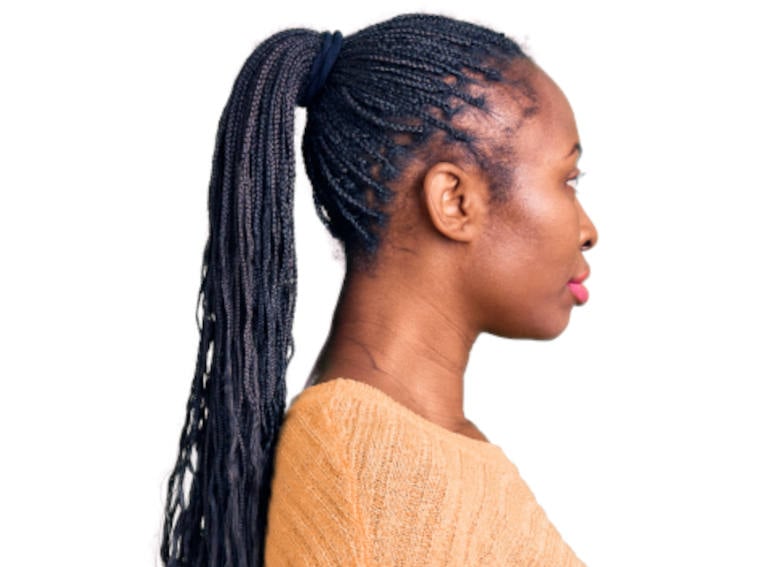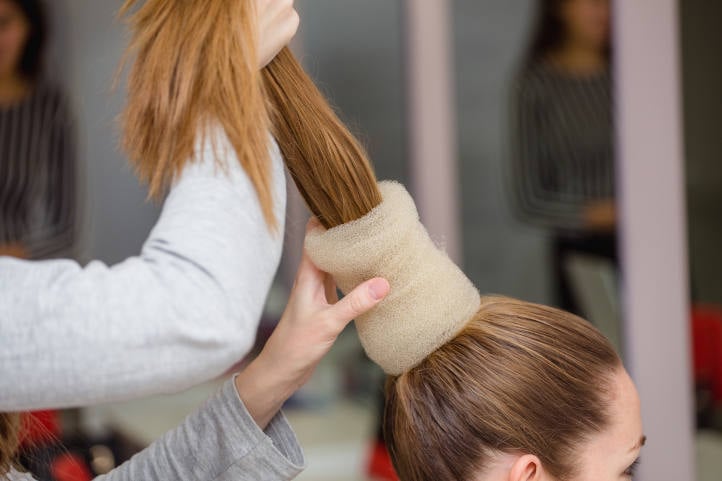
Traction Alopecia – Act at the First Signs
Do you wear your hair tied up or braided very regularly and are starting to lose it around your forehead or temples? It could be traction alopecia!
It is important to treat it so that it does not become permanent. This article explains the reasons for it and how to get rid of traction alopecia.
What is Traction Alopecia?

Traction alopecia or bun alopecia is a type of alopecia caused by excessive tension on the hair by people who wear their hair in tight styles. Specifically, it is when the hair falls out because it is pulled too hard and too often by hair styling practices, causing damage to both the hair and scalp.
Too much hair pulling can be caused by several factors:
- Due to the weight of the hairstyle
- Hairstyles that are too tight
Some causes of alopecia can be related to acute chronic forms, such as trichotillomania. This type of hair loss is caused by compulsive pulling of the hair. In this case, it is advisable to consult a psychiatrist or a psychologist.
If treated early enough, you may be able to learn how to reverse traction alopecia. Otherwise, hair loss can unfortunately be permanent.
Too Much Hair Pulling: Irreversible Consequences
Excessive pulling on the hair fibre damages weakens the keratin of which the hair is composed: the hair may then break at different lengths, which can be one of the traction alopecia symptoms. For example, African American women who regularly wear braids and weaves can gradually weaken their frizzy hair. Traction alopecia celebrities include Naomi Campbell and Christina Aguilera.
But it is under the scalp that we can see the extent of the damage. Under the effect of traction, the hair roots are separated from the hair follicles, responsible for feeding them, and therefore no longer receive sufficient nutrients creating broken hairs.
Effect on the hair growth cycle
This means that they leave the growth phase more quickly and enter the breakdown phase, then rest before falling out. The growth phase that resumes afterwards is therefore also shorter, and so on.
This acceleration of the hair growth cycle eventually leads to permanent baldness. Indeed, each human being has a programmed and limited number of hair cycles. If they are constantly accelerated, this number is depleted more quickly.
The key is simple: act at the first signs of traction alopecia to preserve your hair follicles.
How to Recognize this Form of Hair Loss?
Hair loss is most often localised to the temples and forehead area. However, depending on the type of hairstyle, other areas of the scalp may be affected.
The article in the scientific journal “Indian Journal of Dermatology, Venereology, and Leprology” published in 2017, gives us an exhaustive list of traction alopecia causes:
- Tight ponytails and long braids: temples, top of the ears, frontal line, nape of the neck.
- Long hair twists: tonsure.
- Hair curlers: temples and frontal line.
- Wearing tight scarves: frontal line.
- Tight braids: loss of hair in a V shape on the central parting.
- Weaves: crown hair loss.
- Tight buns: back of the head.
- Glued wig: horseshoe shape, on the top of the head.
How to Avoid Traction Alopecia?
To prevent traction alopecia, leave your hair loose. If you need to put your hair up in a ponytail or bun, keep it loose and low on your head to protect the hair shaft.
Here are also some tips to prevent traction alopecia
- Change your hairstyle regularly. For example, alternate between braids and loose hair.
- When putting your hair up in a ponytail, use a scrunchie instead of a hair elastic. Elastics can pull your hair out.
- Also, avoid using chemicals if you wear weaves or braids – they damage your hair and make it more likely to break.
- If you wear weaves or hair extensions, only wear them for a short time. Take a break between uses.
- When you braid your hair or do dreadlocks, choose thick braids. Thin braids provide more traction.
- Try not to use straightening products.
- Don’t use high heat on your hair dryer and straightening iron.
- Don’t sleep with curlers. Wrap your hair instead.
- If you wear a wig, select one with a satin cap. It won’t pull as hard on your scalp.
Follow these simple guidelines as best you can, and you should be safe from traction alopecia. If the first signs of hair loss are already visible, we recommend that you refer to the next section.
3 Tips for Treating Traction Alopecia
1. Say Goodbye to Tight Hairstyles
If your hair has already started to thin, it’s best to give up the styling habits that led to the hair loss… at least until your hair regenerates.
If that’s not possible, try following the guidelines in the previous section.
2. Boost Hair Growth Naturally
Eat a healthy, varied diet to give your hair roots the nutrients they need.
Implement a hair treatment routine to promote hair growth. Dr. Balwi has developed a hair growth kit that acts directly on the hair root, provides valuable nutrients and fights against progressive hair loss.
3. Traction Alopecia When is it Too Late?
If after 3 months, no regrowth is visible on your hair, it is probably because your hair follicles are dead. In this case, no product can bring them back. Make an appointment with a dermatologist to rule out alopecia due to other reasons.
A permanent solution may be to regrow the affected areas with a hair transplant. For traction alopecia treatment, the DHI technique is recommended. This procedure allows you to shave only a portion of the scalp, which you can easily hide if your hair is long. To learn more about the process, recovery, and costs of treatment abroad, read our comprehensive guide to hair transplants in Turkey.
Traction alopecia is a condition that is easily treated if it is addressed at the first warning signs. In case of scarring (permanent) alopecia, it is always possible to restore your hair with a DHI hair transplant.
Things to Remember
- Traction alopecia is diagnosed more often in women and is common in the African community.
- The hair loss is due to heavy or tight hairstyles worn for a long time.
- To avoid traction alopecia, alternate hairstyles and do not wear them too tightly.
- To stimulate growth, it is recommended to use hair care products or food supplements for hair.
- If the hair does not grow back despite treatment, it is always possible to restore the hair with a DHI transplant.
FAQ
What are the early signs of traction alopecia?
Early signs include redness, bumps, and tenderness along the hairline or where the hair is being pulled. Hair may also start to break or thin in those areas.
How can I differentiate between traction alopecia and other types of hair loss?
Traction alopecia is specifically related to tight hairstyles and is usually localized to areas where the hair experiences the most tension, unlike other types of hair loss which may be more diffuse.
Can traction alopecia be reversed if caught early?
Yes, if caught early and if the tension on the hair is reduced or eliminated, hair can often regrow. It’s important to stop wearing tight hairstyles immediately.
What types of hairstyles are least likely to cause traction alopecia?
Loose hairstyles, such as loose buns, ponytails, or wearing hair down, are less likely to cause traction alopecia. Alternating hairstyles regularly can also help.
Are there any specific products that can help treat traction alopecia?
Products that promote scalp health and hair growth, such as minoxidil, gentle shampoos, and nourishing hair oils, can help. It is best to consult a dermatologist for personalized recommendations.
How long does it take to see improvement after changing hairstyles?
Improvement can be seen within a few months if the tension on the hair is reduced or eliminated. Full recovery may take longer, depending on the severity of the hair loss.


